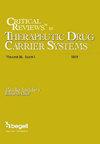抗衰老纳米制剂综述:纳米药妆辅料的最新发展和监管指南。
IF 3
4区 医学
Q2 PHARMACOLOGY & PHARMACY
Critical Reviews in Therapeutic Drug Carrier Systems
Pub Date : 2022-01-01
DOI:10.1615/CritRevTherDrugCarrierSyst.2021039544
引用次数: 1
摘要
皮肤老化是一个渐进的生物过程,通常以皱纹、老年斑、皮肤松弛和干燥为特征。由于皮肤是身体外观的重要组成部分,这导致人们越来越关注皮肤护理。抗衰老产品通过滋养皮肤,帮助改善皮肤质量和健康。然而,由于颗粒尺寸大,它们的效果较差。纳米技术在局部抗衰老产品中的应用对产品性能有显著影响。脂质、聚合物和金属纳米颗粒由于其更小的尺寸而显示出潜在的优势,如增强的稳定性和有效性。这些纳米制剂中使用的赋形剂在提高产品的功效和保质期方面起着重要作用。赋形剂的优化选择对提高纳米制剂的疗效和稳定性起着重要作用。在过去的三十年中,化妆品配方中的天然成分已被广泛认为是安全和毒性较小的。本文的目的是回顾用于抗衰老的纳米配方以及潜在的赋形剂,目前市场上的配方,以及用于化妆品的专利申请。最近有关纳米化妆品监管方面的更新也得到了强调。本文章由计算机程序翻译,如有差异,请以英文原文为准。
A Review of Anti-Aging Nanoformulations: Recent Developments in Excipients for Nanocosmeceuticals and Regulatory Guidelines.
Skin aging is the progressive biological process generally characterized by the appearance of wrinkles, age spots, sagging of skin, and dryness. Since skin is an essential part of physical appearance, this has led to increased concerns about skincare. Anti-aging products help in improving the quality and health of the skin by nourishing it. However, due to large particle size they are less efficacious. Nanotechnological approaches for topical anti-aging products have a significant effect on the product performance. Lipidic, polymeric, and metallic nanoparticles have shown potential advantages like enhanced stability and efficacy due to their smaller size. The excipients used in these nanoformulations play an important role in improving the efficacy and shelf-life of the product. The optimal selection of excipients plays a major role in the nanoformulation approach for their enhanced efficacy and stability. For the past three decades the ingredients of natural origin for cosmetic formulations have been widely recognized for being safe and less toxic. The objective of this article is to review the nanoformulations used in anti-aging along with the potential excipients used, currently marketed formulations, and patents filed for cosmetic use. Recent updates related to regulatory aspects of the nanocosmetics have also been highlighted.
求助全文
通过发布文献求助,成功后即可免费获取论文全文。
去求助
来源期刊
CiteScore
5.50
自引率
18.50%
发文量
27
审稿时长
>12 weeks
期刊介绍:
Therapeutic uses of a variety of drug carrier systems have significant impact on the treatment and potential cure of many chronic diseases, including cancer, diabetes mellitus, psoriasis, parkinsons, Alzheimer, rheumatoid arthritis, HIV infection, infectious diseases, asthma, and drug addiction. Scientific efforts in these areas are multidisciplinary, involving the physical, biological, medical, pharmaceutical, biological materials, and engineering fields.
Articles concerning this field appear in a wide variety of journals. With the vast increase in the number of articles and the tendency to fragment science, it becomes increasingly difficult to keep abreast of the literature and to sort out and evaluate the importance and reliability of the data, especially when proprietary considerations are involved. Abstracts and noncritical articles often do not provide a sufficiently reliable basis for proper assessment of a given field without the additional perusal of the original literature. This journal bridges this gap by publishing authoritative, objective, comprehensive multidisciplinary critical review papers with emphasis on formulation and delivery systems. Both invited and contributed articles are subject to peer review.

 求助内容:
求助内容: 应助结果提醒方式:
应助结果提醒方式:


